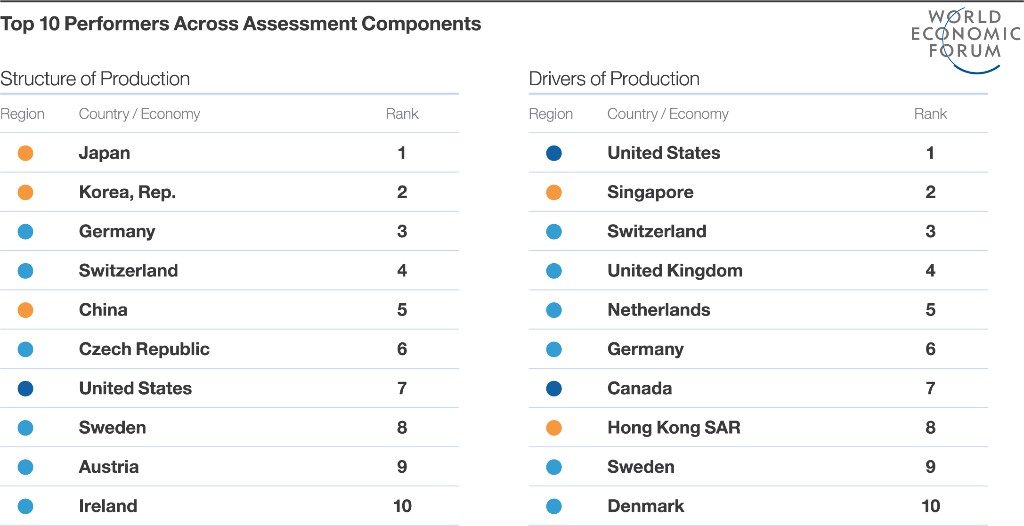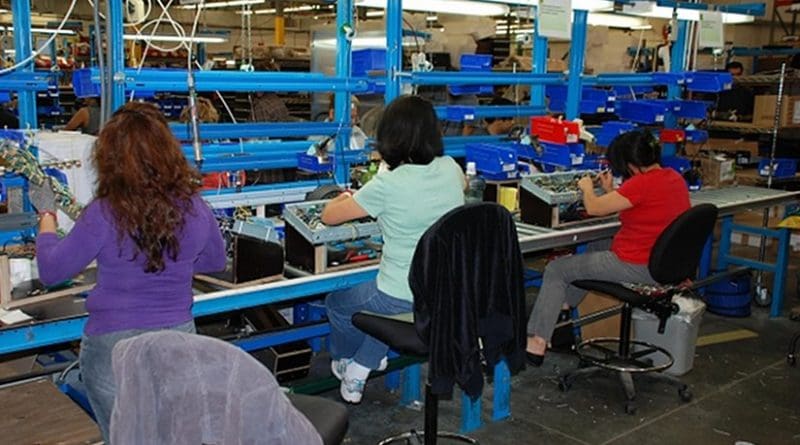Manufacturing Transformation Set To Create Two-Speed World
A new report launched by the World Economic Forum reveals that only 25 countries are in the best position to gain as production systems stand on the brink of exponential change. Recognizing the impact of the Fourth Industrial Revolution and emerging technologies on new production systems and business models, the Readiness for the Future of Production Report 2018, developed in collaboration with A.T. Kearney, provides a snapshot of today’s global production landscape along with potential responses.
The new framework is made up of two main components: Structure of Production, which measures a country’s scale and complexity of production; and Drivers of Production – the key enablers that position a country to capitalize on the Fourth Industrial Revolution to transform production systems. Recognizing that each country has its own unique goals and strategy for production and development, participants are assigned to one of four archetypes: Leading (strong current base, high level of readiness for the future); High Potential (limited current base, high level of readiness for the future); Legacy (strong current base, at risk for the future); or Nascent (limited current base, at risk for the future).
 Helena Leurent, Head of the Future of Production System Initiative of the World Economic Forum, said, “Our work seeks to shape a future where new technologies in production systems help unlock human potential, tackle and solve challenges that have previously been insurmountable, and where all benefit. This report is intended to catalyse discussion between public and private sectors on the factors and conditions required, inform the development of modern industrial strategies, and define areas of collaborative action.”
Helena Leurent, Head of the Future of Production System Initiative of the World Economic Forum, said, “Our work seeks to shape a future where new technologies in production systems help unlock human potential, tackle and solve challenges that have previously been insurmountable, and where all benefit. This report is intended to catalyse discussion between public and private sectors on the factors and conditions required, inform the development of modern industrial strategies, and define areas of collaborative action.”
Along with further qualitative analysis, the initial assessment reveals eight main findings:
- Global transformation of production systems will be a challenge, and the future of production could become increasingly polarized in a two-speed world. The 25 countries in the Leading archetype account for over 75% of global manufacturing value added (MVA), while 90% of the countries from Latin America, Middle East, Africa and Eurasia included in the assessment have a low level of readiness.
- Different pathways will emerge as countries navigate the transformation of production systems. Advanced manufacturing will not be the chosen path for all: some may seek to capture traditional manufacturing opportunities in the near term, while others will pursue a dual approach, or prioritize other sectors altogether.
- All countries have room for improvement. No country has reached the frontier of readiness, let alone harnessed the full potential of the Fourth Industrial Revolution in production. While there are early leaders to learn from, these countries are also still navigating the early stages of transformation.
- Common challenges within each archetype indicate potential future pathways for Leading, Legacy, High Potential and Nascent countries. Countries can learn from each other, while pursuing their own unique strategy.
- Technological advancement brings the potential for leapfrogging, but only a handful of countries are positioned to capitalize. Lagging countries can potentially enter emerging industries at a later stage without the legacy costs of earlier investment, but only if they have the right set of capabilities and develop effective strategies for capturing leapfrogging opportunities most relevant to them.
- The Fourth Industrial Revolution will trigger selective reshoring, nearshoring and other structural changes to global value chains. Emerging technologies will change the cost-benefit equation for shifting production activities and, ultimately, impact location attractiveness. All countries must develop unique capabilities to make them attractive production destinations and capitalize on these shifts.
- Readiness for the future of production requires global, not just national, solutions. Globally connected production systems need not only sophisticated technology but also standards, norms and regulations that cross technical, geographical and political boundaries, to release efficiencies and make it easier to do business across global value chains.
- New and innovative approaches to public-private collaboration are needed to accelerate transformation. Every country faces challenges that cannot be solved by the private sector or public sector alone. New approaches to public-private collaboration that complement traditional models are needed to help governments quickly and effectively form partnerships that unlock new value.
Johan Aurik, Managing Partner and Chairman of A.T. Kearney, said, “In a changing production landscape, each country will need to differentiate itself, capitalize on competitive advantages and make wise trade-offs in forming its own unique strategy for the future of production. Given the speed and scale of changes occurring in the environment, the new diagnostic and benchmarking tool can help raise awareness and sharpen a country’s response.”

